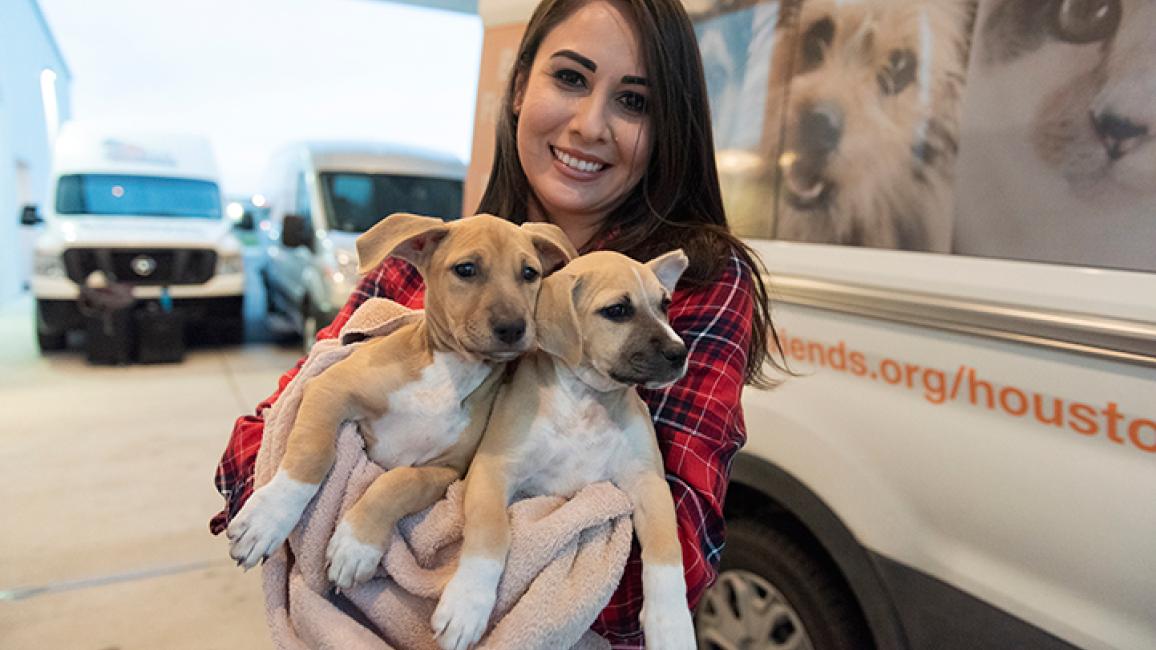800-dog transport from Tex-Mex border begins

Today’s the day! The first 70 of 800 puppies and small dogs that we will be transporting out of south Texas by Thanksgiving are hitting the road in Edinburg. The idea is to get them to partner organizations so that they will be ready for adoption by the holidays.
OK, I admit it. I have a thing about Texas. On one hand, it’s really real and it’s also really cool. On the other, it has been a train wreck for shelter animals. At the moment, I’m stuck on the latter. Significantly more dogs and cats are killed in Texas shelters than in any other state and that makes Texas a top priority for Best Friends’ campaign to make the country no-kill by 2025.
One of the most heartbreaking animal control shelters in the state is in Edinburg, a city located right at the bottom of the state next to McAllen on the Rio Grande. The shelter is the Palm Valley Animal Center (PVAC), which holds animal control contracts with 14 municipalities in Hidalgo County. Last year, PVAC took in close to 30,000 dogs and cats and less than 10,000 got out alive.
Last month, I blogged about the overlooked Palm Valley Animal Center and Best Friends’ commitment to helping to turn that operation around. In 2017, only one-third of the pets entering the shelter were saved. This year, thanks to PVAC’s commitment to change and Best Friends’ commitment to no-kill, the save rate is on track for around 50 percent. There is still a hill to climb, but that’s tremendous progress in less than a year.
I recently visited Edinburg and walked the shelter’s rows of kennels and cages. I was stunned by the number of puppies and small dogs they had there — what rescuers refer to as “cream puffs,” “cherries” and “fluffies.” Dogs that would prompt adoption competitions in most communities or that people can only acquire from breeders or pet stores have a 50/50 chance of survival in Edinburg. Crazy!
The most impactful way to make a lifesaving difference for one of the most challenged shelters in the country is to ramp up transports from Edinburg to adoption-guaranteed shelters and rescue groups that rarely see puppies and small dogs. What better time of year to begin than the holiday season?
Our goal is to jump-start transports from this area of south Texas with a target of 800 dogs being moved to receiving shelters during the next month. The first 70 dogs are headed to La Plata County Humane Society in Durango, Colorado, MaxFund Animal Center in Denver and Watermelon Mountain Ranch in Rio Rancho, New Mexico, where they will be checked out and will be lighting up lives in their new homes soon.
Do highly adoptable dogs from outside a community displace local dogs in need and put a drag on no-kill efforts? Actually, no. Quite the reverse. It’s just like any other retail promotion: The idea is not just to sell the items on sale, but to generate a lot more traffic through the store, or in this case, the shelter. The goal is to get lots of eyes on all the shelter animals. Receiving shelters that promote the arrival of at-risk rescued pets, whether they are from a natural disaster or a struggling shelter, invariably increase adoptions across the board. (Like when you went to that store to check out the half-price jeans sale and left with the jeans, a shirt and a pair of hiking boots.)
Why so many puppies and purebred dogs in the Palm Valley area? There are a number of contributing factors, including a shortage of low-cost spay/neuter services; a very rural, agricultural population that regards many types of dogs as ranch and farm hands; and high levels of poverty.
Before you snipe at south Texas, though, remember that a big piece of getting Los Angeles Animal Services to the doorstep of no-kill was transports, just like this, of thousands of small dogs to the Northwest and the Northeast. Such transports continue currently for Los Angeles County shelters.
These 800 dogs are just the first in a long-term south Texas transport project that’s part of a larger plan to help PVAC and Hidalgo and neighboring counties to implement common-sense programs and policies that will put them on the path to achieving no-kill by 2025.
Before too long, we will look back upon the last 150 years of shelter killing and wonder what we were thinking, but right now there’s a lot of work to do, so get those transports rolling!
To keep up with the journey of #800Pups, follow us on Twitter @BestFriends.
Together, we will Save Them All.
